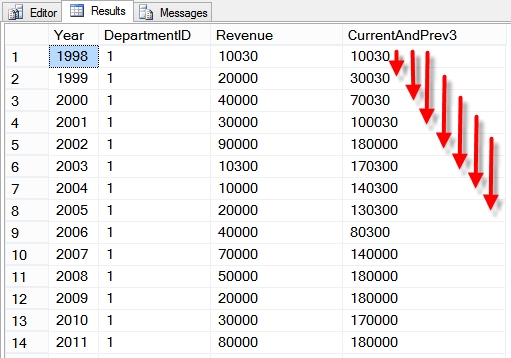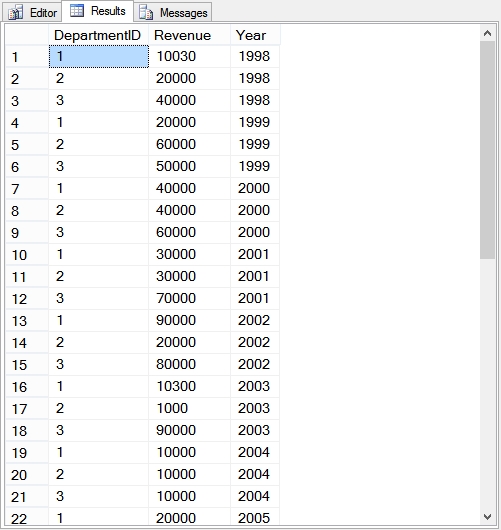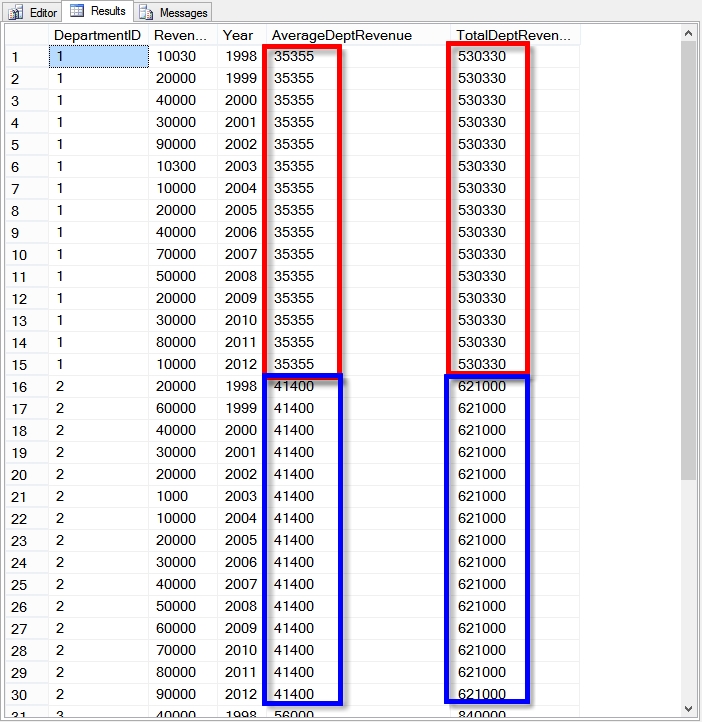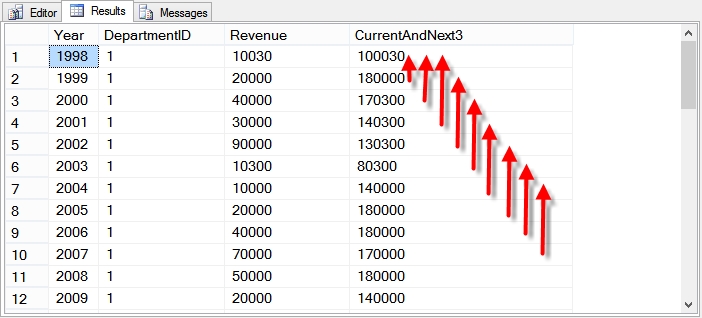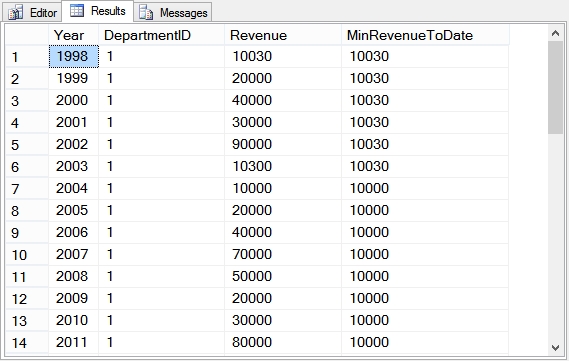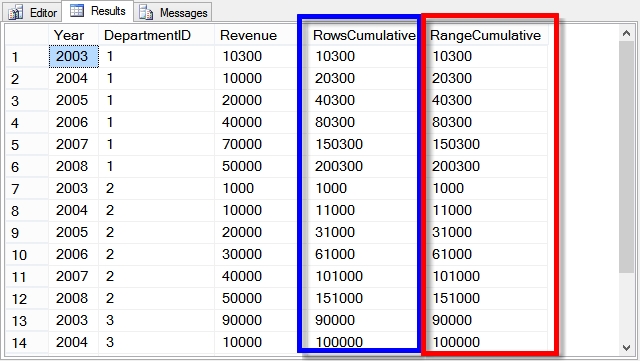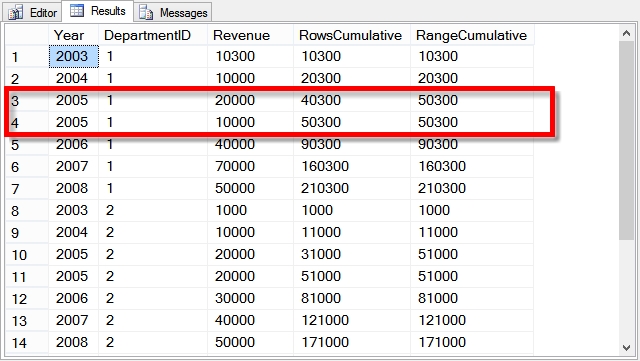This feature has been available since SQL server 2012 and is one of my favorites. It is the Rows/Range enhancements to the over clause. These enhancements are often times referred to as the windowing functions.
Overview:
ROWS PRECEDING, FOLLOWING, UNBOUNDED, refers to the current row and those before or after based on preceding or following.
RANGE PRECEDING, FOLLOWING, UNBOUNDED, means all values in the current range and those before or after.
An example of a need for rows preceding would be to calculate a 3 year trailing average, which needs to look at the current year and the three previous years in the calculation.
Terminology:
ROWS or RANGE- specifying rows or range.
PRECEDING – get rows before the current one.
FOLLOWING – get rows after the current one.
UNBOUNDED – when used with PRECEDING or FOLLOWING, it returns all before or after.
CURRENT ROW
To start out we need a database to work on, so we will create a tsql2012 database. you can use your own database if you wish.
CREATE DATABASE [tsql2012]; GO USE [tsql2012];
Next we create a table to use for the over clause enhancments of rows and range preceding and following.
-- Table to be used by Over Clause Rows/Range CREATE TABLE REVENUE ( [DepartmentID] int, [Revenue] int, [Year] int ); insert into REVENUE values (1,10030,1998),(2,20000,1998),(3,40000,1998), (1,20000,1999),(2,60000,1999),(3,50000,1999), (1,40000,2000),(2,40000,2000),(3,60000,2000), (1,30000,2001),(2,30000,2001),(3,70000,2001), (1,90000,2002),(2,20000,2002),(3,80000,2002), (1,10300,2003),(2,1000,2003), (3,90000,2003), (1,10000,2004),(2,10000,2004),(3,10000,2004), (1,20000,2005),(2,20000,2005),(3,20000,2005), (1,40000,2006),(2,30000,2006),(3,30000,2006), (1,70000,2007),(2,40000,2007),(3,40000,2007), (1,50000,2008),(2,50000,2008),(3,50000,2008), (1,20000,2009),(2,60000,2009),(3,60000,2009), (1,30000,2010),(2,70000,2010),(3,70000,2010), (1,80000,2011),(2,80000,2011),(3,80000,2011), (1,10000,2012),(2,90000,2012),(3,90000,2012);
Take a look at the revenue table to see whats there before we start the demo.
USE [tsql2012]; -- first lets look at the REVENUE table SELECT * FROM Revenue;
Contents of the REVENUE table.
Then a quick review of sum and avg.
-- first simple sum and avg aggregates SELECT sum(Revenue) as TotalRevenue, avg(Revenue) as AverageRevenue, count(*) as NumRows FROM Revenue;
OVER Clause Pre SQL Server 2012
The OVER clause before SQL Server 2012 is really handy to perform aggregates over a different range than your standard grouping.
--First OVER Clause pre SQL 2012 SELECT *, avg(Revenue) OVER (PARTITION by DepartmentID) as AverageDeptRevenue, sum(Revenue) OVER (PARTITION by DepartmentID) as TotalDeptRevenue FROM REVENUE ORDER BY departmentID, year;
ROWS PRECEDING
Now the new features, ROWS PRECEDING specifies the the aggregate functions in the current partition in the OVER clause will consider the current row, and a specific number of rows before the current row.
--ROWS PRECEDING -- look at the sum of revenue over a trailing 3 year period SELECT Year, DepartmentID, Revenue, sum(Revenue) OVER (PARTITION by DepartmentID ORDER BY [YEAR] ROWS BETWEEN 3 PRECEDING AND CURRENT ROW) as CurrentAndPrev3 FROM REVENUE ORDER BY departmentID, year;
ROWS FOLLOWING
Now rows following… The ROWS FOLLOWING option specifies a specific number of rows in the current partition to use after the current row.
-- ROWS FOLLOWING SELECT Year, DepartmentID, Revenue, sum(Revenue) OVER (PARTITION by DepartmentID ORDER BY [YEAR] ROWS BETWEEN CURRENT ROW AND 3 FOLLOWING) as CurrentAndNext3 FROM REVENUE ORDER BY departmentID, year;
Both PRECEDING and FOLLOWING
Using both ROWS PRECEDING and ROWS FOLLOWING allows you to do things like calculate an average including the current year and years both before and after the current year.
--ROWS PRECEDING AND FOLLOWING SELECT Year, DepartmentID, Revenue, sum(Revenue) OVER (PARTITION by DepartmentID ORDER BY [YEAR] ROWS BETWEEN 1 PRECEDING AND 1 FOLLOWING) as BeforeAndAfter FROM REVENUE ORDER BY departmentID, year;
UNBOUNDED
UNBOUNDED PRECEDING tells the windowing function and aggregrates to use the current value, and all values in the partition before the current value.
-- ROWS UNBOUNDED PRECEDING SELECT Year, DepartmentID, Revenue, min(Revenue) OVER (PARTITION by DepartmentID ORDER BY [YEAR] ROWS UNBOUNDED PRECEDING) as MinRevenueToDate FROM REVENUE ORDER BY departmentID, year;
When using UNBOUNDED FOLLOWING as follows, this means the use the current row, and consider all rows after the current row in the current partition.
-- ROWS UNBOUNDED FOLLOWING -- http://stevestedman.com/?p=1485 SELECT Year, DepartmentID, Revenue, min(Revenue) OVER (PARTITION by DepartmentID ORDER BY [YEAR] ROWS BETWEEN CURRENT ROW AND UNBOUNDED FOLLOWING) as MinRevenueBeyond FROM REVENUE ORDER BY departmentID, year;
ROWS vs RANGE
ROWS vs RANGE appears to cause much confusion.
ROWS means the specific row or rows specified, and RANGE refers to those same rows plus any others that have the same matching values.
Here is an example of ROWS and RANGE producing the exact same results because the years and department IDs don’t have any duplicates. In this case the ROWS and RANGE are identical.
-- ROWS vs RANGE UNBOUNDED PRECEDING SELECT Year, DepartmentID, Revenue, sum(Revenue) OVER (PARTITION by DepartmentID ORDER BY [YEAR] ROWS UNBOUNDED PRECEDING) as RowsCumulative, sum(Revenue) OVER (PARTITION by DepartmentID ORDER BY [YEAR] RANGE UNBOUNDED PRECEDING) as RangeCumulative FROM REVENUE WHERE year between 2003 and 2008 ORDER BY departmentID, year;
Now if we consider the same query of ROWS vs RANGE with duplicate values. Here we insert a duplicate set of values for 2005, and the results below show that for the year 2005 there are two rows in the result set, and the RowsCumulative column is different form the RangeCumulative. The rows counts the specific rows it the aggregate calculation, the range counts the current row, plus the other 2005 rows for that department id.
-- INSERT A DUPLICATE VALUE FOR RANGE UNBOUNDED PRECEEDING INSERT INTO REVENUE VALUES (1,10000,2005),(2,20000,2005),(3,30000,2005); -- same query as above SELECT Year, DepartmentID, Revenue, sum(Revenue) OVER (PARTITION by DepartmentID ORDER BY [YEAR] ROWS UNBOUNDED PRECEDING) as RowsCumulative, sum(Revenue) OVER (PARTITION by DepartmentID ORDER BY [YEAR] RANGE UNBOUNDED PRECEDING) as RangeCumulative FROM REVENUE WHERE year between 2003 and 2008 ORDER BY departmentID, year;
Summary
With all the great new features in SQL Server 2012, the windowing functions, ROWS and RANGE, PRECEDING and FOLLOWING updates to the OVER clause are a great addition.
More from Stedman Solutions:

Steve and the team at Stedman Solutions are here for all your SQL Server needs.
Contact us today for your free 30 minute consultation..
We are ready to help!
